By The Time I Get To Phoenix
Recorded live at Veteran Memorial Coliseum.
September 9, 1970. Phoenix, AZ.
Tracklisting
Recording: Audience
Notes: By The Time I Get To Phoenix (one line), Sweet Caroline (+ false start), The Wonder Of You, Don't Be Cruel.
Sound:  Contents: Contents:
Covers: [front] [back]
Other Releases
Concerts Reviewed - 1970
BACK ON THE ROAD AGAIN - PHOENIX '70.
Peter Butler
Phoenix, AZ - September 9, 1970:
When Elvis Presley appeared before 13,300 people at the Veteran Memorial Coliseum, Phoenix, Arizona, at 8:30pm., on Wednesday, 9th September 1970, he had not toured since October 1957. After the success of those first three Las Vegas seasons, it was decided that he would go back on the road again, and re-establish his ties with a wider public. Colonel Tom contacted promoters Jerry Weintraub (managing the still to be discovered John Denver) and Tom Hulett (of Concerts West). Both had made names for themselves via successful tours by top flight acts like Eric Clapton, Cream, Led Zeppelin, and Jimi Hendrix. They joined forces and started running tours in 1969. The short tour would begin just two days after the 10th August - 7th September engagement at the International Hotel in Vegas ended. In all there would be eight concerts in what was essentially seen by all as a 'test run'. After the opening show there was St. Louis (10/9), Detroit (11/9), Miami (12/9 - 2 shows), Tampa (13/9 - 2 shows), and Mobile (14/9). On the Colonel's orders, right-hand-man Tom Diskin had the opening show set up like Vegas regarding the sound system and stage. With Elvis sidelined in the army, then Hollywood and Vegas from the 50's onwards, no one appears to have bothered to check out modern sound system technology. Elvis would go on in Phoenix with two on-stage monitors and the 'in-house' system for the audience, however good or bad it might be. This was the only show where that would happen. Management III (Weintraub, Hulett, and Terry Bassett from Dallas, who put up much of the money) took over the next day and installed a realistic system. Parker insisted that tickets be priced at $5, $7.50, and $10, but no more. This favoured everyone. They all made money and the venues sold out. In fact they sold out within hours of box offices opening. Typical for the Colonel, everyone had to pay, even Elvis when wanting seats for family and friends. With each venue holding at least 10,000 people (except Tampa with 7,500, but two shows were performed), Elvis would receive something in the range of $100,000 per show. There was a bomb threat in Phoenix just prior to the show. The audience had to be evacuated. After a detailed search, nothing was found. While the band were aware of the situation, Elvis wasn't told. He found out later from a newspaper report and it annoyed him a great deal. This came a year after death threats in Las Vegas and he couldn't understand that someone could really want to hurt him. Elvis wasn't happy either when he found out that The Imperials weren't coming with him. They had another booking in Nashville, and said that the Colonel hadn't given them enough notice or time to make plans. It's been claimed that this was a negotiating ploy by the group. Whatever the case, they were replaced by the Hugh Jarrett Singers, a group assembled for just this tour by the ex-Jordanaire. Joe Guercio too would find himself on the spot. Just he and a single trumpet player from his large Las Vegas orchestra would go on the road. Other, additional, musicians would be picked up at each stop. Not the best arrangement. Apart from the above, there was comedian Sammy Shore. He, along with the Jarrett Singers and Sweet lnspirations (Ann Williams, Myrna Smith, Sylvia Shemwell, Estelle Brown), occupied the stage for the opening hour. Then Elvis "bounced on stage". He was supported by what would become the regular touring band, and was in fact the now set Vegas team: James Burton (lead guitar), John Wilkinson (rhythm guitar), Jerry Scheff (bass), Glen D. Hardin (piano), Ronnie Tutt (drums), Charlie "Kate Smith" Hodge (acoustic guitar), and Kathy Westmoreland (highvoice singer). The opening theme fills the air. A nervous and apprehensive Elvis, dressed in a white fringe and beaded suit, with green leaf belt and scarf, opens with fast and furious versions of "That's All Right" and "I Got A Woman", which falters at the end. He jokes, "Good evening ladies and gentlemen. My name is Glen Campbell," and does a line of Jimmy Webb's "By The Time I Get To Phoenix" (in Detroit on the 11/9 he would sing a line of "Detroit City"). Then we're into a typical Vegas version of "Love Me Tender", with comments from the king to those reaching for him. At the end he says "I'd like to tell you it's really a pleasure to be here. It's my first appearance like this in about nine years". The last time being "1957, when I was just a baby!". He introduces "I've Lost You", and does a very good version of his new hit. Most of the familiar material is arranged and performed as in "That's The Way It Is". He intro's Neil Diamond's song "from last year. You guys know 'Sweet Caroline'?" The band answer with the intro only. It's a mess. Elvis laughs, says "Hold it! We didn't wanna do the song anyway!" Someone from the audience requests a song. He comes back with "I'll do 'em all before the night's over. Just hang loose man!" Quickly he goes into a vocally strong version of "You've Lost That Lovin' Feelin"', though he does forget the lyric shortly after the start, at the verse change. The "if this suit weren't too tight" line in included too. By now it's clear that the audience is made up of people around Elvis' age, their thirties. They want to hear the sounds of their youth, but are equally ready to listen to the more recent material. "Polk Salad Annie" is next. A crazy, wild take of the Tony Joe White swamp rocker. Elvis is all over the stage. The crowd reacting to every little twitch of a limb. Ronnie is going mad too, and Elvis gets Jerry to play some neat bass licks. Then he shouts the names of other entertainers, including "Jones" and "Humperdinck", then "me!", getting laughs as he performs a move in the style of each, but never missing a beat! Afterwards he struts around, getting his breath back. Introductions of the black clad musicians come now, though only James gets a solo spot, on "Johnny B. Goode". We get the "Tutt and Scheff" gag too. Elvis goes into a fine version of "The Wonder Of You", complete with Burton licks. "In The Ghetto" starts out well, but he's fooling around, "It's a sad song Charlie!", before the close. The 'oldies' section includes "Heartbreak Hotel", "Blue Suede Shoes", and "Hound Dog". He plays around at the start of "Hotel", and "Blue Suede" has a "white suede" slipped in towards the start. Returning to modern material, Paul Simon's "Bridge Over Troubled Water" receives a very strong performance. This is perhaps the performance of the concert. Following this he says how, as a kid, he was doing "all that stuff (Tom) Jones is doing now!". Much laughing is heard. To demonstrate his point, he throws himself into "Suspicious Minds". Just about shaking himself to pieces at the end. Tom was never this wild, this animalistic. Then it's over. A brief comment and "Can't Help Falling In Love" starts up. Its familiar opening notes and performance, though not so familiar back then to the people as the end. The closing vamp comes, as does "Elvis has left the building". People stand, talk, make their way out to go home. Only the night air hitting them makes them realize that this was no dream. Elvis Presley had appeared in concert in their town. Memories for a lifetime made in around forty-five minutes. Dynamic is a word often overused these days, like superstar and charisma, when describing a performer and their performance. For Elvis though, such words are really only adequate. True. He didn't move in the way he once had. He moved in a-far more current and 'hip' way. Even today, footage of these early 70's concerts, be it official or bootlegged, is breathtaking. He spins, bends, kicks, punches, and jumps. Perfectly emphasizing the music. Becoming the music. At times he seemed firm and rock solid, a white pillar. Then he is rubber, liquid even. So fluid that only his suit seems to contain him. His body as much a part of the music as his voice and the instruments which created it. You can almost believe that the music would suddenly cease if he stopped moving, leaving just endless screaming. From the limited visual evidence, plus a less than perfect audio source, it's still obvious to anyone that Elvis delivers. The show is full of action, physical and vocal, plus humour. Despite the use of the house system, the crowd appear ecstatic with everything Elvis does, and the sound is surprisingly good on the audience recorded audio cassette. Most of what is said can be both heard and understood. Local reporter Thomas Goldthwaite wasn't so impressed at the time though. His column the very next day was titled "Presley fans were 'unlucky"' (Phoenix Republic 10/9/70). While he admitted that "the voice is better than ever", he attacked just about everything else, from supporting acts, "It was mayhem", to Elvis' material, "some inferior songs of little impact", and that sound system, "one of the most wretched amplification systems ever devised"! Listening to the show, the crowd sound very enthusiastic rather than "unlucky", as is so often the case when comparing a recording to a print report. It has to said though that this very first concert, where the style and rules were yet to be carved in stone, contains all the potential for the great shows which would follow. It also has the seeds of everything which would go wrong and see Elvis become bored and restless. This is yet another contradiction in the artistic life of this unique artist. The sound of Elvis' voice at this time can be clearly heard throughout "That's The Way It Is" and, while bootleg recordings from the September tour don't do it and its power justice, the studio session of the 22nd September 1970, where he performs the light and breezy country number "Snowbird", the gospel like "Where Did They Go, Lord?", the rockin' "Whole Lotta Shakin' Goin' On", and the operatic "Rags To Riches", these show how the voice had stood up to the short tour. And this was a session that was recorded by an Elvis who was said to be in a rush to get away! It's long been claimed that MGM filmed footage of Elvis in Phoenix for "That's The Way It Is". The UK publication "Elvis A-Z" (Albert Hand Publications, 1976) lists the movie and notes, "Commenced July 1970. Stage act filmed Las Vegas Aug. 1970. Stage act filmed Phoenix Sept. 1970." It only lists, as do many publications, the opening "Mystery Train/Tiger Man" medley as coming from the concert. Later, "Recording Sessions" (Jee Productions, 1984) would state that this was not the case, though it doesn't say where or when the medley was recorded. A version appeared on the 3 CD set, "That's The Way It Is - Special Edition" in 2000. Listed as coming from Vegas on the 12th August 1970, it isn't the same version as that which opens the movie. As we now see, Elvis didn't even perform "Mystery Train/Tiger Man" in Phoenix! Thereby destroying that decades old myth about those first scenes in the film. It's a fact that the houselights were up at the Veterans Memorial Coliseum, but MGM has always maintained that this was to allow for a little "location filming". They filmed Elvis' entrance and then the audience, for about ten to twelve minutes. This was simply to get footage of the wilder on the road crowd, as opposed to the far more reserved Las Vegas set. This might explain also, given the reaction at the show, why the next movie would be "On Tour", and not back in Vegas again? In the end the Phoenix footage was used at the start of the film, minus sound, around Elvis' Las Vegas performance. While there's doubt as to whether MGM recorded the sound at Phoenix, they did do a limited amount of still photography. Some of the pictures appeared on the reverse of the original "That's The Way" LP sleeve. While it's easy to see and understand what director Denis Sanders sent his crew to Phoenix for, what their task was at this show. That they didn't turn their cameras around and focus on this ultimate hurricane of entertainment, it must rank as nothing less than a tragedy. Those still photographs can only hint at what a performance those assembled witnessed... Peter Butler Note: Arjan Deelen provided this article. Thanks Arjan.  
CONCERT DATE: September 9 1970 (8:30 pm). Phoenix AZ. Presley fans were "unlucky"
By Thomas Goldthwaite
Arizona Republic
September 10, 1970
If Col. Tom Parker doesn't watch out, his extraordinary property, Elvis Presley, could be headed toward life in a wax museum. And no doubt your true Presley fan, ardent, crazy and by now nostalgic, would be just as happy to have it that way. Presley's return to Phoenix last night after 13 years of increasing fortune, if not fame, brought a full house at the Memorial Coliseum of 15,000 persons, Presley fans every one of us: and every one of us perhaps too much wanting him to pick up where he left off here in 1957. He obliged only too briefly in a rapid fire, false-start, almost impatient string of his early hits: "Blue Suede Shoes," "Hound Dog," and "Heartbreak Hotel." He could have gone a full hour in such vein and torn the house down. As it was, the audience was wholly shell-shocked from a preceding hour of all kinds of acoustical enormities inflicted on them by lesser talents, one of the most wretched amplification systems ever devised and an unfortunate box office snarl owing to an early evening bomb scare. No need to dwell on that first hour: four men called the Hugh Jarrett Singers, who looked in their 30s, had potbellied postures of the late 40s and harmonic difficulties mindful of senior citizens. Their rapport with the audience was good natured but darned corny: "Doggone, you're a good audience!" cried the smiling leader. Next came a group of seven called Sweet Inspiration who seemed inspired only to deafen everyone. All of this racket abeited by a 15-piece band under Joe Guercio. It was mayhem, but not in the rock manner of today or even yesterday. It was the hellist kind Renaissance painters used to depict in things like "The Last Judgment" This is where canny Col. Parker misjudged the times. His clients are not soul searchers. They are cornball Presley fans and it was obvious they came to remember what this creature was like. That he hasn't adapted very well to the music of today - he tried several times last night, abandoned one song and forgot the lyrics to another - is simply a painful reality for all of us. When he bounced on stage, a mixture of Lord Byron and Davy Crockett, all done up in white with Kelly green scarf and sash, the American flag might as well have appeared for the mighty roar that went up, for all the excitement and popping of flash bulbs. It was then one saw the audience for what it was: a thirtysh crowd with the best of good will and full of hope. Elvis greeted them warmly, sang some inferior songs of little impact and still waved off the shouting from all about for the old hits ... his hits of 10, 15 years ago. What he felt at the response is unknown. He's enjoying a universal rebirth at Las Vegas where no doubt his old fans clamor for the old hits, too. He flopped a bit like the old days, though it seems stylized now and rather like a Kachina mime, posed, pointed, stabbed and sprawled. But there is less of that now. The voice is better than ever. Swooping a quivering vibrato passionate gasps and a solid baritone. He conducts final chords with great (...). His "Love Me Tender" was tossed off to swooning females where once it was oozed all over them. Still they (..) and rolled and gasped last night, eager as ever to catch his glance or one supposed a drop of his sweat. They paid $1 for an old fashioned photo album and probably today will buy "Elvis' 50 Golden Hits" on RCA for $15. MGM brought its cameras to the Coliseum to film the show as a finale for a documentary due at Thanksgiving. Courtesy of Sebastiano Cecere CONCERT DATE: September 9, 1970. Phoenix, AZ. Don't Call Him "Pelvis" Just Call Him The King
by Ken Burton
Tucson Daily Citizen
September 10, 1970
PHOENIX - "Whatever you call Elvis Aaron Presley, don't call him The Pelvis. The Legs, The Elbows, The Knees, maybe. But not The Pelvis. As Elvis himself told 14,000 screaming fans at the Coliseum here last night: "Ah was just a kid when ah did that other stuff." The "other stuff" was a bump and grind routine that made Presley's hips look like they had ball bearings instead of marrow in the sockets. But all that was more than a decade ago. Last night's show was Elvis' third public appearance since his discharge from the U.S. Army in the late 1950s, excluding his lucrative club engagements, mostly in Las Vegas. A half hour behind the schedule, the show tried to get off the ground at 9 p.m. For an hour, a restless, kind of thirtyish audience suffered through the warmup acts. They included a male quartet known as the Something-Or-Other Brothers, a female quartet called the Sweet Inspirations (who were) and a comedian ("You've all seen him on television, folks, and now here he is..."). The comedian was cut short by clapping. Intermission. Booing. Fifteen minutes passed, the band came back, the lights dimmed. Elvis, looking as sexy as a 35-year-old can look, sauntered onto stage. Before you could say "Don't Be Cruel," the squeals went up - largely from the part of the audience that must have been 3 or 4 years old, when Elvis started the whole thing. Then it was worth the wait. There was something borrowed ("That Lovin' Feelin "from the Righteous Brothers), something new ("Kentucky Rain"), something old ("Hound Dog") and something blue ("In The Ghetto.") Through it all, the fans thundered their approval, while Elvis fell on the stage, writhed (nearly), laid down, got up, shook his healthy locks alot and even kidded himself a little! about not being as young as he once was. There was no kidding the press, though, who had a choice of tickets at $10, $7.50 and $5 for the privilege of reviewing the show. And no interviews. Said an aide to Presley's manager, Col. Tom Parker, from Las Vegas last week: "We just won't have time for that sort of thing." Nor did they have time for press photographers, including one from the Tucson Daily Citizen. They were first asked for credentials, allowed to shoot The King and were then summarily yanked by their collars away from the stage. And there was no kidding the audience, periodically blinded by klieg lights while an M-G-M crew filmed portions of the show for a forthcoming movie. It will be called, oddly enough, "Elvis." It was a two-hour show and Elvis was on stage for about 45 minutes, the fringe of his super mod white outfit flying as fast as the flashbulbs. There was "Love Me Tender," too, which brought to mind that Elvis for years was accompanied by The Jordannaires, who have since passed by the wayside or whatever it is that groups like that do. And there was the properly planned spontaneous throwing of a neck scarf to a fan in a front row seat. She screamed well enough to be a member of the Class of 1955, but she wasn't old enough. Elvis dashed out a side exit, rocking less but rolling more in money. Not bad for the kid who started out as a $35-a-week "truck driver in Mississippi. Courtesy of Mr. Archie Bald CONCERT DATE: September 9 1970 (8:30 pm). Phoenix AZ. The Presley Era And Where It Has Gone
by Jerry Eaton
The Arizona Republic
October 18, 1970
Fourteen years ago the author covered Elvis's first Phoenix show for The Arizona Republic. In 1956 a 21-year-old singer grabbing for his slice of stardom kayoed 5,000 screaming teen-agers, mostly girls. They surged against a chain link fence in an attempt to reach him. They climbed over and under fences to enter the Arizona State Fairground. They bent up the bottom of an iron sliding gate to gain admission. Elvis Presley was a symbol of a wild, new breed, anti-Establishment, unpredictable. His performance had the social impact of an atom bomb. It delighted youths, angered parents and infuriated teachers and ministers. Today Presley, although sometimes exciting, is perhaps past it. The old Presley magic did burn bright enough a few weeks ago to permit him to almost transform a show bomb into a success. For an hour, the crowd at the Coliseum suffered through three preliminary acts, clapping occasionally to indicate their displeasure. After intermission, Presley shuffled unannounced into the blazing spotlights wearing a white fringed shirt which laced up the front; white, slightly flared trousers, white shoes and green scarf. He put the audience into his pocket immediately just as he did in 1956. But they kept slipping away from him. Their enthusiasm waned. They forced him to reach into the past to sing the standards - Heartbreak Hotel, Hound Dog, and Love Me Tender. Many remembered Elvis the boy. That night they saw Elvis the man whose facial lines betray his 35 years. They remembered a shadow and they heard, for the most part, past-tense songs because it was a past-tense show. Elvis in his appearance in Phoenix in 1956 wore a dark blue suit and red knit shirt. He stepped high in a quick jig when drums, bass fiddle and guitar filled in. He doesn't undulate as much today but when he does, he turns on. His twisting, turning continues to please as much as the songs he bellows. The delighted shrieks follow. But they're fleeting. In 1956, the yells were sustained. Presley, amused by the screams he heard at the Coliseum, said, "I was doin' this when Tom Jones was just a little, ol' kid." The 1956 crowd in Phoenix which heard Elvis was Korean War, Eisenhower vintage. They saw in Presley their dreams for sexual freedom and social change. Elvis squirmed and wiggled in his tight pants and teenage girls screamed and sobbed. Elvis The Pelvis, circa 1956, sang until the wax melted on his hair. He belted out one big song after another as his guitar thumped on his chest. He was whisked to the outdoor stage at the fairground in a Cadillac. He departed in the same car a few hours later. He and his adoring fans were physically and emotionally exhausted. His voice, mannerisms, gestures, dark flashing eyes and deep dimple suggested to the tender, young crowd embraces on lover's lane, a departure from the routine, overt naughtiness. He was the idol of motorcycle gangs who wore black, leather jackets and tattoos on forearms and who rode fast with slim blondes clinging to their waists. Fourteen years ago, Elvis was the whole show. His worshippers were those in the early and midteens who visualized him as a rebel, a non-conformist, a lover. On stage, he still exudes sex, sin, stolen pleasures. Audiences continue to be dazzled by his body - wide shoulders tapering to a slim waist, long sideburns almost to the jaw, wild, unruly hair hanging in his face, the twists, the turns, the bumps and grinds. When he loosened his green scarf and tossed it away, there were screams of delight. When he tugged at the laces of his shirt, girls and women cheered. "Turn this way, Elvis" a woman called from the balcony. Elvis responded grinning. Fans called out names of songs they wanted him to sing and Elvis said, "Before the night is over, baby, you'll have it all." Presley has done it all before. He appeared a little bored and tired about the whole thing. He stopped singing one song. "I don't sound very good on this one tonight," he said. Another song bombed and Presley knew it. "That was supposed to be sung seriously," he said to his accompanists. Teen-agers were there bu the socio-economic composition of the crowd was different than in 1956. The Establishment was on hand - blondes, brownettes, brunettes, Presley's contemporaries and those not many years his junior. Presley's male contemporaries were there, too - ex-motorcycle drivers who have shed black, leather jackets for business suits and other garb of the real world of work, veterans of Seoul and Pork Chop Hill, professional men, mid-managers, others. They were all there - the beautiful people, the well-mannered, well-dressed teen-agers, a few senior citizens, some fading flower children, some younf bearded hippies. The teen-agers of the 1950s are today's pushing-40 adults. They sat on comfortable chairs in the refrigerated Coliseum in contrast to the 1956 outdoors show on a hot, dusty night. The women streamed into the coliseum in miniskirts, pants suits, dark hosiery, high heels, plunging necklines. They were dressed to the hilt for husband and Elvis, Their men walked beside them wearing ties, white shirts, dress trousers and sport coats. Survivors of the 1950s and the golden age of Presley were conspicuous with obsolete ducktail haircuts meticulously combed and held in place by wax. From the balcony, Elvis resembled in his white costume a middle-age tennis player, a karate student and a physician on TV's Marcus Welby, M.D. When Elvis sensed the audience was drifting he brought them back again with the big rock songs of the '50s. He was backed up by a chorus of eight men and women who overpowered him when he faltered on some high notes. They added a musical dimension contrasting to Presley's damn-the-torpedoes, full-steamahead treatment of almost every song. Elvis sang a lot, talked little. He fumbled for the name of the band accompanying him and someone rescued him with a cue card. Photographs and other Presley memorabilia sold big during the 1956 appearance but in 1970 youthful sellers of Presley photo albums wandered up and down the stairs of the Coliseum finding few takers. Since the 1950s, the nation has become saturated with young, middle-age and senior citizen imitators of Elvis The Pelvis. Customers today can pick the pelvis of their choice in assorted shapes, sizes and colors - solos, doubles, trios, quartets, quintets, rock, soul and the rest. In the two decades since the daddy of them all blazed onto the scene, a nation of young people has been weaned on Vietnam, inflation, assassinations, drugs, The Generation Gap, burn baby burn. They bought Elvis at the Coliseum about as much as they buy anything. He turned them on as much as anything. But to them now he's just another millionaire who puts on his tight trousers one leg at a time, a rich guy who doesn't walk on the water. After he finished 55 minutes on stage, Elvis walked off abruptly and the audience began to applaud tentatively, hoping for an encore. Shortly, a voice of an unseen announcer said, "Elvis has left the building. He will not return." This time no Cadillac whisked him off Prince Charming-like while he waved to his adoring fans as in 1956. There was no last display of the deep dimple, no last word-not even two fingers signifying peace. The guys and gals from the Korean War years and the Vietnam War years and the Now Generation filed out of the Coliseum into the warm night. They talked of tomorrow and its problems, diets unfaithfully followed, the kids in school, the neighbors down the street. They discussed almost everything except Elvis. Courtesy Of Archie Bald |
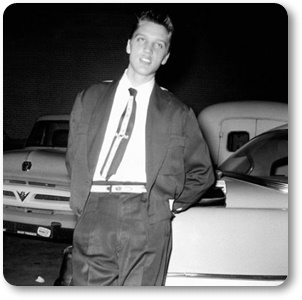
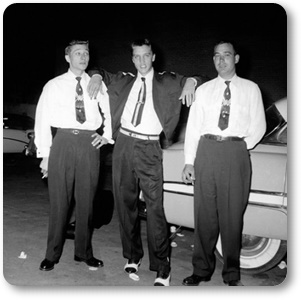
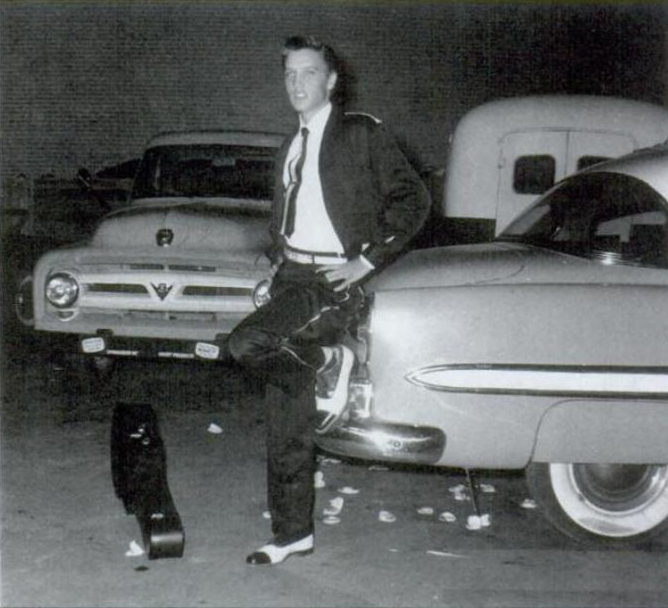
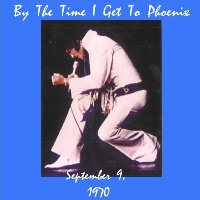
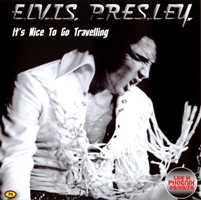
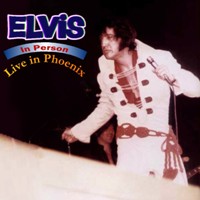
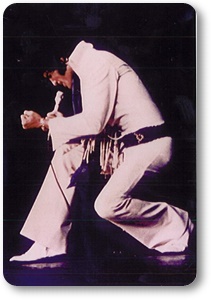
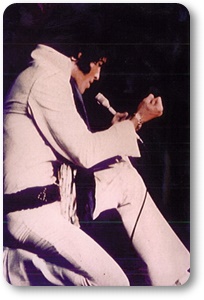
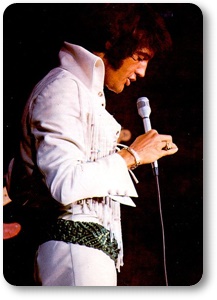
 Contents:
Contents:

No hay comentarios:
Publicar un comentario